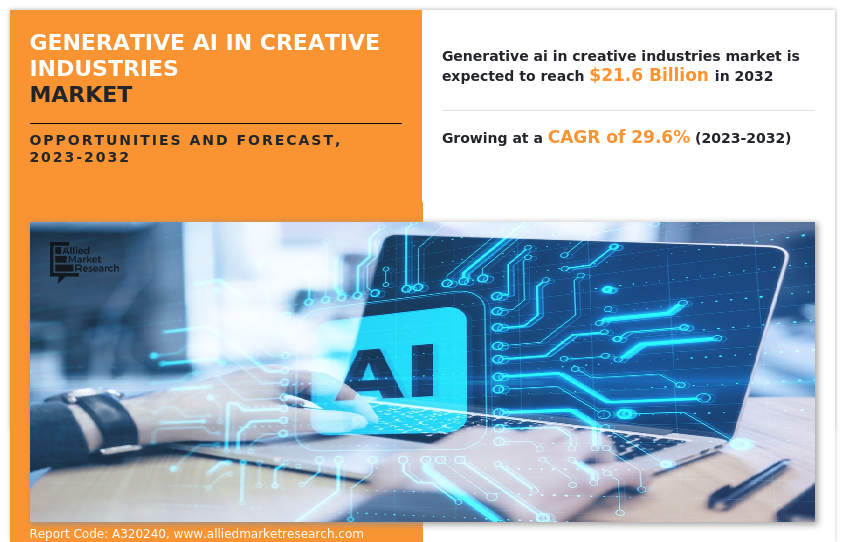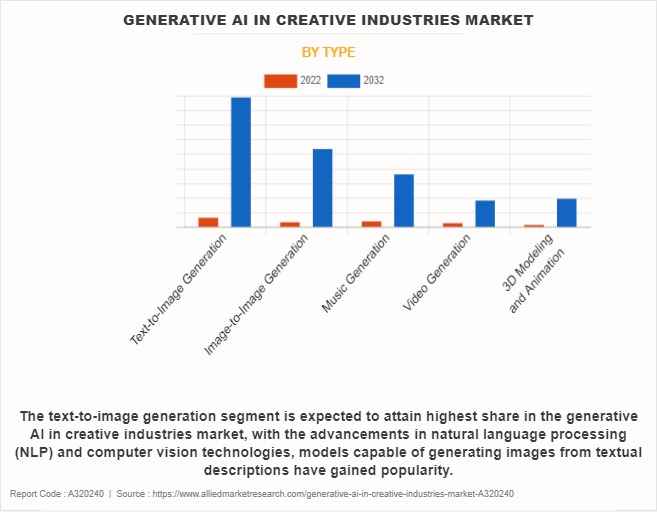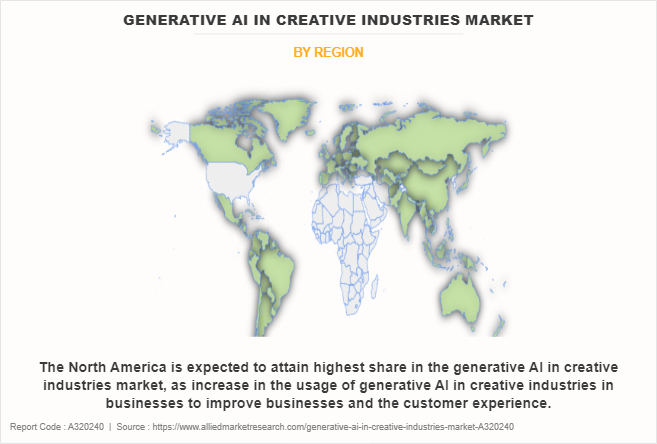Generative AI In Creative Industries Market Overview
The global generative AI in creative industries market size was valued at USD 1.7 billion in 2022, and is projected to reach USD 21.6 billion by 2032, growing at a CAGR of 29.6% from 2023 to 2032.
Generative AI is a type of artificial intelligence that creates new material using machine learning techniques by identifying patterns and instances in existing data. Generative AI can create music, art, design, literature, and other creative outputs with innovation and distinctiveness by learning from massive volumes of creative data. Large phrases and image posts on social media, blogs, and articles may all be automatically produced by AI models. This is expected to be a useful time-saving tool for businesses and individuals that frequently generate content.

In addition, the integration of cutting-edge innovations such as artificial intelligence, ML, and distributed computing is expected to create advantages for organizations and customers, including identifying and answering arising issues even more efficiently. A generative AI solution also helps improve efficiency and productivity for businesses and reduce costs. Moreover, it provides enhanced data filtering solutions and a better user experience for end users. In addition, generative AI solutions provide flexibility and scalability to adapt to evolving threat landscapes and changing business requirements. Such factors are anticipated to provide lucrative opportunities for the generative AI in creative industries market growth during the forecast period.
Moreover, increase in advancements in AI technology and rise in demand for personalized content are the factors expected to propel the growth of the global generative AI in creative industries market. However, risks related to the data breaches are anticipated to hamper the growth of global market. On the contrary, surge in integration of AR and VR in creative industries is further expected to create lucrative opportunities for the growth of the global market.
The report focuses on growth prospects, restraints, and trends of the generative AI in creative industries market share analysis. The study provides Porter’s five forces analysis to understand the impact of various factors, such as bargaining power of suppliers, competitive intensity of competitors, threat of new entrants, threat of substitutes, and bargaining power of buyers, on the generative AI in creative industries industry.
Segment Review
The generative AI in creative industries market is segmented on the basis of deployment mode, type, application, and region. By deployment mode, the market is segmented into on-premise and cloud. On the basis of type, the market is segmented into text-to-image generation, image-to-image generation, music generation, video generation and 3D modeling and animation. On the basis of application, the market is segmented into gaming, film and television, advertising and marketing, music and sound production and others. Region-wise, it is analyzed across North America, Europe, Asia-Pacific, Latin America, and MEA.

Based on the type, the text-to-image generation segment dominated the generative AI in creative industries market share in 2022 and, is expected to maintain its dominance during the forecast period, with the advancements in natural language processing (NLP) and computer vision technologies, models capable of generating images from textual descriptions have gained popularity, which is further expected to propel the overall market growth. However, the image-to-image generation segment is expected to exhibit the highest growth during the forecast period, as there is a growing need for automated tools that generate high-quality images efficiently, which in turn propel this segment growth in the global market.

By region, North America dominated the market share in 2022 for the generative AI in creative industries market share growth. The presence of technological businesses is insistently influencing the advancement of the market. However, Asia-Pacific is expected to exhibit the highest growth during the forecast period. This is attributed to the expansion of advanced technologies such as communication systems, cloud computing, and others, which further contribute to the growth of global market.
Top Impacting Factors
Increase in advancements in AI technology
The increasing adoption of AI technologies in creative industries such as film and television, music industry, digital studios, and others. has proliferated the demand for generative AI in creative industries solutions. It is the key to optimizing business operational processes with the integration of advanced AI technologies and other digital solutions. In addition, the implementation of AI technologies in businesses can be beneficial in data analytics and predictive insights. Large amounts of IoT-generated data may be analyzed by AI algorithms to spot trends and fetch insightful knowledge. Moreover, the increasing advancements in data analytics, machine learning, and deep learning technologies enable AI to process IoT data more accurately. These aforementioned factors are anticipated to propel the generative AI in creative industries market growth.
Risks related to the data breaches
Security and privacy maintenance of data have become complex with an increasing amount of user information associated with IoT devices. In addition, concerns regarding the security of data are rising due to the rising volume of data generation on internet devices.
Further, the increased use of IoT, in particular for networking of a large number of projects, has given rise to new threats and hazards associated with IT security. These threats include infiltration of malware through removable media and external hardware, human error and sabotage, social engineering, and phishing, Distributed Denial of Service (DDoS) attacks, technical malfunction, and force majeure, among others. These threats affect business operations to be restricted in an unplanned manner, which negatively impacts punctuality and allocation of resources in generative AI in creative industries solutions. Thus, security and privacy concerns about consumer details and other confidential information cause unethical privacy, which is hindering the growth of the generative AI in creative industries market.
Surge in integration of AR and VR in creative industries
Increasing adoption of augmented and virtual reality applications in this technological and digital world has proliferated the demand for generative AI in creative industries. Additionally, the rising popularity of these technologies across a variety of sectors is one of the key factors influencing the rising demand for AR and VR applications in creative industries. VR has been employed in the gaming sector to produce immersive gaming environments that offer customers the impression that they are actually playing the game. In the educational sector, augmented reality has been utilized to provide engaging learning activities that help students in comprehending difficult ideas. Thus, the technological breakthrough in the development of various sector’s operation led to surge in growth of generative AI in creative industries market.
Competition Analysis:
Competitive analysis and profiles of the major players in the global generative AI in creative industries market include Alphabet Inc., Microsoft Corporation, IBM Corporation, Nvidia Corporation, Adobe Inc., Autodesk, Inc., Unity Software Inc., OpenAI, Inc., Synthesis AI and Epic Games, Inc. These major players have adopted various key development strategies such as business expansion, new product launches, and partnerships, which help drive the growth of the generative AI in creative industries market globally.
For instance, in January 2023, Shutterstock, Inc. launched its AI image generation platform, available to use by all Shutterstock customers globally in every language the site offers. The text-to-image technology converts prompts into larger-than-life, ethically created visuals ready for licensing. It is the latest addition to Creative Flow, Shutterstock's extensive toolkit that has been specifically designed to power the most seamless creative experience possible.
Recent Developments in the Market:
In March 2023, Adobe launched generative AI model Firefly. The new AI model will also be available for use in other products offered by the company such as creative cloud, document cloud, experience cloud and adobe express.
In May 2023, WPP partnered with NVIDIA, to enable creative teams to produce high-quality commercial content faster, more efficiently and at scale while staying fully aligned with a client’s brand.
Key Benefits for Stakeholders
This report provides a quantitative analysis of the market segments, current trends, estimations, and dynamics of the generative AI in creative industries market forecast from 2022 to 2032 to identify the prevailing market opportunities.
Market research is offered along with information related to key drivers, restraints, and opportunities of generative AI in creative industries market outlook.
Porter's five forces analysis highlights the potency of buyers and suppliers to enable stakeholders to make profit-oriented business decisions and strengthen their supplier-buyer network.
In-depth analysis of the generative AI in creative industries industry segmentation assists in determining the prevailing generative AI in creative industries market opportunity.
Major countries in each region are mapped according to their revenue contribution to the global market.
Market player positioning facilitates benchmarking and provides a clear understanding of the present position of the market players.
The report includes an analysis of the regional as well as global generative AI in creative industries market trends, key players, market segments, application areas, and market growth strategies.
Generative AI in Creative Industries Market Report Highlights
| Aspects | Details |
| Forecast period | 2022 - 2032 |
| Report Pages | 350 |
| By Deployment Mode |
|
| By Type |
|
| By Application |
|
| By Region |
|
| Key Market Players | Unity Software Inc., epic games, Autodesk, Inc., Synthesis AI, Inc., IBM Corporation, NVIDIA Corporation, Microsoft Corporation, Adobe Inc., OpenAI, Alphabet (Google Inc.) |
Analyst Review
As the generative AI in creative industries market continues to evolve, CXOs are evaluating the opportunities and challenges regarding this emerging technology. Businesses acknowledge the significance of continuous advancements in AI technologies are likely to impact the generative AI in creative industries Market. Businesses are considering the benefits that generative AI in creative industries solutions can offer, including the capability to provide an effective means to process the data, preserve legal compliance, and decrease the potential of data breaches and unauthorized access. In addition, implementing effective generative AI in creative industries solutions help businesses to maintain the privacy and authenticity of data, safeguarding their enterprise reputation and avoiding potential legal consequences. Such factors are expected to provide lucrative opportunities for the market growth during the forecast period.
Furthermore, the integration of Internet of Things (IoT) and industry 4.0 principles into creative industries is driving the demand for advanced AI solutions. However, businesses also recognize the challenges associated with generative AI in creative industries solutions. One potential risk is the complexity and usability challenges. This type of software is complicated to deploy and use and may require technical knowledge and additional processes to encrypt and decrypt data, which can make it challenging for organizations to enhance their product offerings in communication services. In addition, generative AI in creative industries solutions require significant investment in security infrastructure and technological expenses, which can be a major restraint for the global market.
Furthermore, rise in concerns regarding interoperability issues is expected to limit the global market growth. There could be incompatibilities between the regulatory standards and protocols used by various communication solutions, which further hinders the growth of the global generative AI in creative industries market. Businesses must integrate software or applications by specific standards and protocols. By addressing these challenges, businesses can unlock the full potential of generative AI in creative industries solutions to transform their security operations, create value, and gain a competitive advantage in their industry. For instance, in May 2023, Tata Consultancy Services (TCS) partnered with Google Cloud, to design and deploy custom-tailored business solutions that help clients harness the power of this exciting new technology to accelerate their growth and transformation.
Generative AI has emerged as a transformative force within creative industries, revolutionizing the way art, music, literature, and design are produced and consumed. One notable trend is the proliferation of AI-powered tools that enable artists and creators to generate content quickly and efficiently. These tools leverage advanced algorithms, such as deep learning and reinforcement learning, to mimic human creativity and generate original works across various mediums.
Generative AI has found diverse applications across creative industries, enriching artistic processes and pushing the boundaries of creativity. In visual arts, generative algorithms such as Generative Adversarial Networks (GANs) have been harnessed to produce captivating imagery, ranging from photorealistic landscapes to abstract compositions, often surpassing human imagination.
North America is the largest regional market for Generative AI in Creative Industries
$21.54 billion is the estimated industry size of Generative AI in Creative Industries.
Alphabet Inc., Microsoft Corporation, IBM Corporation, Nvidia Corporation, Adobe Inc., Autodesk, Inc., Unity Software Inc., OpenAI, Inc., Synthesis AI and Epic Games, Inc. are the top companies to hold the market share in Generative AI in Creative Industries
Loading Table Of Content...
Loading Research Methodology...



